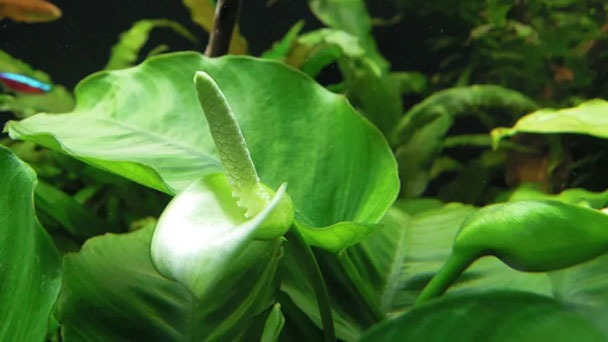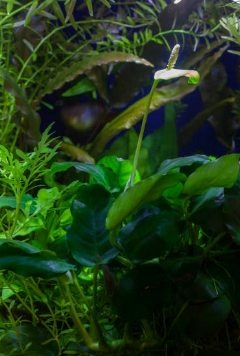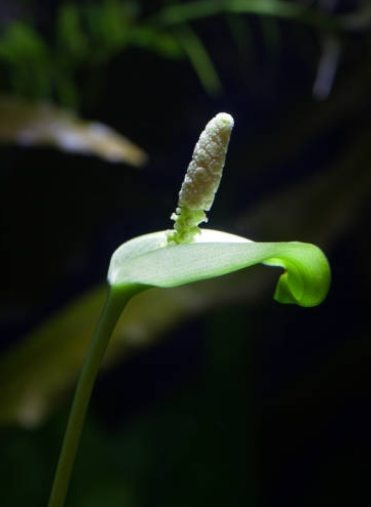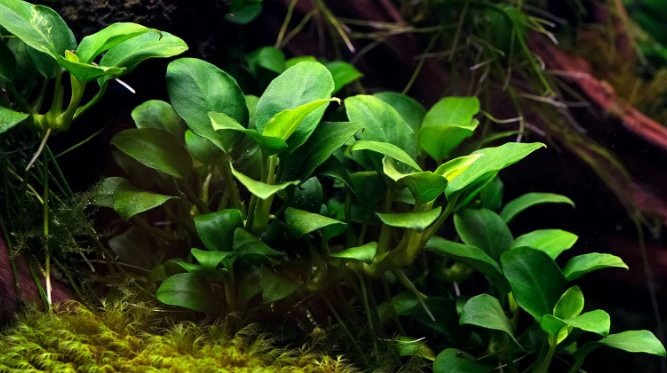Anubias Barteri - Propagation & How to Plant
Written by Ivy
Jan 03 2023

Due to its ease of maintenance and propagation, the Anubias barteri is a common plant among aquarium hobbyists. This aquatic plant can be positioned in the foreground, middle, or background of your aquarium depending on the variety that is available.
Anubias barteri is a fantastic plant to have in most types of freshwater aquariums, say both novice and seasoned hobbyists who specialize in planted tanks.
You can learn all there is to know about Anubias barteri varieties in this article, along with how to take care of this lovely plant. Let's dive right in since there's a lot to learn!
Anubias Barteri Overview
| Class | Liliopsida |
| Order | Arales |
| Family | Araceae |
| Height | 11 to 17 inches |
| Color | Bright to Deep Green |
| Aquarium Position | Variety-dependent; versatile |
| Care Difficulty | Easy; recommended for beginners |

If Anubias Barteri is planted in the substrate, the rhizome must remain above the substrate or the plant will start to rot. This is a rare occurrence. Although it must be kept fastened to the item until it has time to take root, it is frequently attached to rocks, driftwood, or other aquarium decorations. Although thread is typically easier to work with, fishing line can also be used for this.
A high-quality fertilizer should be applied, and this plant will benefit from additional CO2 for growth. It favors a location where there is a lot of water flow, which will lessen the amount of algae and debris that builds up on the leaves. Although this usually requires a certain level of phosphates (around 2ppm), if excellent conditions are present, it may flower.
Anubias Barteri can grow in almost any environment, though it will grow better with good lighting and CO2 supplementation. It has a history of thriving in waters with low nutrient levels and for extended periods of time in nearly total darkness. It is nearly impossible for the aquarist to kill this plant as long as algae growth is under control.
Some aquarists mistake the Anubias barteri for the Anubias nana, another common aquarium plant. In truth, the Anubias species that the barteri and the nana belong to is the same. But the main physical characteristics that set these two variations apart. Anubias nana has smaller leaves and is shorter than Anubias barteri, which also spreads its leaves over a larger area in the aquarium.
How to Care for Anubias Barteri
Lighting
Despite the fact that Anubias Barteri can survive in a variety of lighting situations, medium to high lighting is the ideal. The appearance of this plant in the aquarium will be significantly improved as a result of the faster and more compact growth that will be ensured.
You should aim to provide 2 to 3 watts per gallon of light when selecting a light for this plant. The best type of lighting would be fluorescent, with either T5 or T8 bulbs being acceptable. Although many people don't currently view LED lights as being as dependable as fluorescent lights, they could also be a good replacement for fluorescent bulbs.
Water
When particular water conditions and requirements are kept in the tank, this plant thrives. Anubias are generally known to be slow growers, so you must prioritize keeping lighting, nutrient supplementation, pH, and water hardness well-maintained for proper growth and sustainability.
It should be adequately met because the aforementioned conditions have a big impact on how quickly it grows.
Fertilizers & Substrates
Adding liquid fertilizers in small amounts might work, but it won't usually be necessary. You could tempt an algae-coated fate by adding fertilizers. If you only have anubias or other slow-growing plants in your tank, adding CO2 is probably not going to do you any good.
Making sure your anubias is securely anchored is the crucial step.
It is a fool's errand to try to coax growth out of a plant before its root system is well-established because once that happens, the plant usually explodes in growth. Other than anchoring it firmly where it has room to spread out, there is no way to attempt to hasten the roots' establishment or establishment. Even though anubias can be left to float, their root systems benefit greatly from being anchored.
Temperature
Using a reliable thermometer, make sure the temperature is close to 72 to 82 degrees Fahrenheit (22 to 28 degrees Celsius). The Anubias thrive best in this temperature range.
Maintain a pH between 6.0 and 8.0; any value significantly above this range may be harmful to the plant's health. This can be measured using a pH testing kit, which is affordable and available at pet stores that sell aquarium supplies.
Anubias can withstand a sizable range of water hardness levels. However, the Anubias are best suited to general hardness of 2–15 dGH and carbon hardness of 3–8 KH.
Humidity
Anubia barteri needs moisture in order to survive and develop, just like all other plants. Anubias naturally grows in humid environments, but you can still grow it indoors if you give it enough water to prevent the leaves and roots from drying out. You should keep your plant on a pebble tray or use some other method of humidity control if your home is particularly dry due to central air conditioning or other factors.
A pebble tray or humidifier can help you keep the humidity level between the recommended range of 40% and 60%. Wait until your plant is nearly dry between waterings before giving it another drink. If you're unsure, wait longer between waterings than shorter ones; if your plant turns crispy or yellow, you've waited too long.
How to Plant Anubias Barteri
When it comes to planting Anubias you have a couple of options to choose from. In this section, you'll learn all about how to plant the Anubias barteri in the substrate or attached to decorative elements already positioned in your aquarium.
1. Settling Down in Substrate
If you choose to plant your Anubias barteri in the substrate of your aquarium, you mustn't bury its rhizome completely. Rhizome rot and eventual plant death will result from burying the plant's rhizome beneath a few inches of substrate.
Instead, you should only partially cover the Anubias' rhizome. Plant the rhizome in the substrate so that it can still be seen clearly on the substrate's surface. As a result, it will have enough room to develop a strong root system and grow horizontally.
At this stage, you should keep your newly planted Anubias away from rowdy fish or nosy bottom-feeders. You can grow Anubias steadily if you place it far from areas with a lot of fish activity and water disturbance.
2. Attaching to Decorative Elements
You can also plant the Anubias barteri by simply attaching its rhizome and roots to rocks or wooden decorations inside your aquarium. Use rubber bands or thin fishing lines to accomplish this quickly.
Carefully wrap the string of your choice slightly above the plant's rhizome and then tie it securely to the rock or wood debris in your tank. The best place for the rock or wood that an infant Anubias barteri is attached to in the aquarium is somewhere where fish don't frequently go or where strong currents don't disturb the area.
After you successfully plant the Anubias barteri in your aquarium, give it a few days to adapt to the water conditions in the tank. Anubias can be grown successfully without the use of most fertilizers or chemical additives. The amount of light your aquarium receives should be carefully considered.
Too little lighting will result in your Anubias suffering from stunted growth, while too much will cause algae growth. You can just let your Anubias grow at its own pace, keeping in mind the light level in your tank and how your fish interact with your plants.

Anubias Barteri Propagation: Tips and Tricks
Propagating anubias is an easy process. You simply need to cut off parts of the rhizome while making sure to leave at least three to five healthy leaves per rhizome part. In the same manner as you planted the parent plant, you can then plant these young Anubias. Here are some other suggestions:
Have a Propagation Tank Ready
One suggestion is to have a propagation tank ready to ensure proper growth and propagation of new Anubias barteri shoots. You don't need a sizable or feature-rich aquarium for your propagation tank.
If you want, you can even choose to use empty containers as a propagation tank. The most important lesson from this is that you should have a separate tank or container that you can use for the young shoots that you separate from the parent Anubias.
This approach has several advantages. The first benefit is that your new Anubias plants will have a spot to grow unmolested. Second, if you grow your young plants in a separate container, there is less chance that fish will nibble on them or eat them. Finally, having a propagation tank will allow you to keep an eye on the baby Anubias plants and pick which ones to put in the fish tank, give to friends, or place in other habitats.
Propagate the Healthiest Plants Only
Sometimes, when choosing plants for propagation, hobbyists do not choose the healthiest varieties. The resulting plants are usually weak, small, and prone to illnesses. Be highly selective of the plants you want to propagate. Anubias barteri is undoubtedly among the hardiest plants in the hobby, but it is not completely immune to issues like algae overgrowths, melting stems, root rot, and many others.
Observe your Anubias plants before deciding which ones to propagate and which ones to prune or remove from the tank. When you need to take care of multiple Anubias barteri in the future, doing this will save you a ton of time and effort.
Avoid Overcrowding Your Tank With Anubias
When you plant Anubias cuttings in the home tank, avoid positioning them too close to each other. Give each propagated plant at least two to three inches of space between them. This will help you avoid overcrowding the substrate or tank with Anubias, and will also prevent severe competition between the aquatic flora. The movement of your fish may be hindered and the growth of other plants may be stunted in an aquarium with too many Anubias barteri.
Common Problems
Anubias is a resilient and long-lasting plant, but it is not without issues. Anubias is less prone to melting than other immersed-grown plants, unlike many other plants.
Algae
The growth of algae is a common issue; eventually, it will suffocate or outcompete plants. Algae is a symptom of an unbalanced ecosystem; without one of these conditions, it wouldn't be able to establish itself.
Slow Growth
It's a slow-growing plant, so slow growth isn't necessarily a problem. The main problem here is a greater lack of patience. It's worthwhile to anchor your floating plant if you want better growth. In addition, it's a waiting game if your lighting and nutrition appear to be adequate.
For whatever reason, some plants never seem to grow, while those next to them experience explosive growth. There is no need to be concerned about it. It could be that their root system established itself better or that their anchoring was better. Replanting or reanchoring the plant could be the solution if you've had it for, say, a year with little growth.
Anubias Rhizome Rotting
It will be better to pull the rhizome up (take the plant out of the tank) and inspect every square inch of the rhizome for signs of rot. When something is rotting, it may be brown or mushy in texture. Eliminate all traces of the decayed tissue. Make sure to cut until you reach crisp, fresh, green, hard tissue. The rhizome can be harmed even by a small amount of rot that has been left behind.
Yellow Spots
The Anubias species frequently experience this issue, which is frequently brought on by bright lighting. Try to move the plant to a shaded area of the tank if this occurs, or add some floaters to dim the light. Iron-containing supplements can be given to the plant to help fight this.
Emersed to Submersed:
an occurrence where the plant starts to die off after purchase. Anubias that have been grown above the surface of the water might have a hard time adjusting to life underwater. Don't worry too much if this happens; while the plant will initially lose its leaves, new ones will eventually emerge.
Anubias Maintenance
You can make caring for your anubias nana as easy or difficult as you like. Naturally, you can increase lighting, add CO2, and fertilizers, but none of this is necessary.
The anubias will have a much better chance if you plant it, but if you're feeling lazy, you can let it float free. Although it has developed an odd golf ball-like shape over time, I have left mine bobbing around my tank for almost two years with no negative consequences.
It is also unnecessary to trim anubias. You can remove one or two of the tallest leaves at a time if it becomes too tall. Your plant will probably stop growing or end up dying if you remove more than one or two leaves at once. You can remove one or two more leaves once some new ones begin to form, but be careful not to over-trimming in order to keep your plant alive. Cut each leaf as closely to the rhizome as you can to avoid the stem rotting and poisoning the rhizome.
Anubias doesn't need any maintenance from you besides those optional tasks.
Anubias Plants Origins
Right off the bat, I think I should explain that the common name "anubias" refers to an entire genus of plants, not just one particular species.
In addition, the most widespread species, Anubias barteri, has a number of cultivars and varieties.
So there are a ton of different plants, but they are all sold under the same common name.
In Africa's tropical regions, this genus of plants is indigenous to freshwater rivers and streams.
Anubias clings to objects like riverbank rocks, roots, or submerged logs.
It can grow either emersed—with the leaves above the water line—or immersed—wholly underwater.
But the plant must remain submerged for its roots and rhizome to survive.

Benefits of Anubias
Anubias is a fantastic substitute for java fern for those who don't want it. Like Java fern, it is equally resilient, adaptable, and simple to maintain. It advances similarly gradually. It offers a better surface for fish to spawn on. These leaves are frequently used by angelfish and other vertical egg layers to lay their eggs, which later hatch into fry.
Since its leaves are so tough, most fish don't want to eat them. It can withstand quite a bit of abuse, even from fish that eat plants, like goldfish. Anubias are the ideal plant for someone who wants to set it and forget it because they don't need a lot of maintenance like trimming, fertilizer dosing, or iron.
Additionally, if you're tired of the run-of-the-mill "easy plants," you'll be spoiled for choice with all the variants anubias comes in!
Final Words on the Anubias Barteri
We certainly covered a lot of ground regarding the Anubias barteri. By now, you should be familiar with its planting and propagation methods. Here is a quick breakdown of the key points from our discussion:
- Freshwater plants are indigenous to Central and Western Africa, including the Anubias barteri.
- It is renowned for its adaptability and toughness.
- It may be rooted in the substrate or fastened to rocks or wood.
- When exposed to too much light, it is susceptible to algae overgrowths.
- This plant is simple to spread.
You probably now understand why the Anubias barteri is a favorite among new aquarists. Try your hand at taking care of this straightforward yet amazing flora in your fish tank.
Latest Updated
- Benefits of Bugleweed - 7 Science-backed Health Benefits
- Bugleweed Dangers & Side Effects - Is It Poisonous?
- How to Plant Evergreen Trees - What You Should Know
- When to Plant Evergreens - Grow Guide for Evergreen Trees
- 12 Wonderful Evergreen Shrubs for Your Garden
- 12 Popular Evergreen Plants with Pictures for Beginners
- When And How To Prune A Lilac Bush Like a Pro
- How to Grow & Care for Lilac Vine (Hardenbergia Violacea)
- Japanese Lilac Tree (Syringa Reticulata) Care & Propagation Guide
- Shumard Oak Pros and Cons - What to Know
Popular Articles
- Winter maintenance of Antirrhinum Majus
- How to Grow Terminalia Mantaly Tree
- How to Grow and Care for Crossostephium Chinense
- How to grow Antirrhinum Majus in spring
- Peristeria Elata (Dove Orchid) Profile: Info & Care Guide
- Underwatered Snake Plant (Sansevieria Trifasciata) - Signs And How To Fix
- How to Care for Brazilian Jasmine Plant (Mandevilla Sanderi)
- How to Grow & Care for Graptopetalum Purple Delight in Summer
- Rosa Chinensis (China Rose): Plant Growing & Care Tips
- How to Care for Baby Sun Rose (Aptenia Cordifolia)